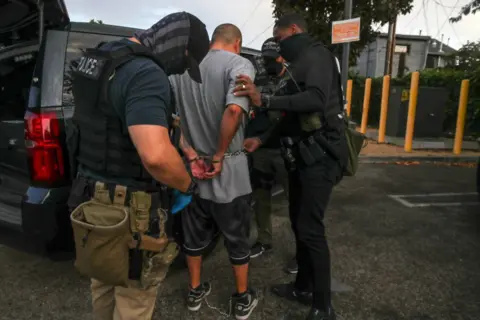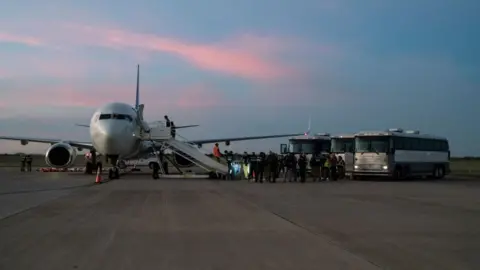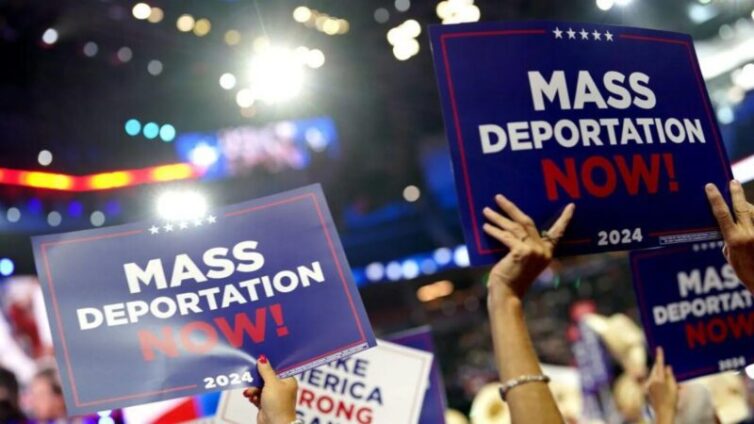US President-elect Donald Trump has doubled down on his campaign promise of the mass deportation of illegal immigrants, saying the cost of doing so will not be a deterrent.
In some of his first public remarks since winning the election, Trump said his priority upon taking office in January would be to make the border “strong and powerful".
"It’s not a question of a price tag. It’s not - really, we have no choice," Trump told NBC News.
"When people have killed and murdered, when drug lords have destroyed countries, and now they’re going to go back to those countries because they’re not staying here. There is no price tag."
While his campaign has given various answers as to how many could be removed, his vice-president-elect JD Vance had said they would start with one million.
In Thursday’s phone interview with NBC, Trump partially credited his message on immigration as a reason he won the race.
"They want to have borders, and they like people coming in, but they have to come in with love for the country," he said. "They have to come in legally."
Experts say there are significant legal and practical challenges to expelling so many people at once.
Immigration advocates have also warned that the human cost of deportations would be significant, with families torn apart and raids taking place in communities and workplaces across the US.
What are the legal challenges?
The latest figures from the Department of Homeland Security and Pew Research indicate that there are around 11 million undocumented immigrants currently living in the US, a number that has remained relatively stable since 2005.
Most are long-term residents - nearly four-fifths have been in the country for more than a decade.
Immigrants who are in the country without legal status have the right to due process, including a court hearing before their removal. A drastic increase in deportations would likely entail a large expansion in the immigration court system, which has been beset by backlogs.
Most immigrants already in the country enter into the deportation system not through encounters with Immigration and Customs Enforcement (Ice) agents but through local law enforcement.
However, many of the country’s largest cities and counties have passed laws restricting local police co-operation with Ice.
Trump has pledged to take action against these “sanctuary cities”, but America’s patchwork of local, state and federal laws further complicates the picture.
Kathleen Bush-Joseph, a policy analyst at the Washington-based Migration Policy Institute, or MPI, said that co-operation between Ice and local officials would be a "critical" aspect of any mass deportation programme.
"It's much easier for Ice to pick someone up from a jail if local law enforcement co-operates, instead of having to go look for them," she said.
As an example, Ms Bush-Joseph pointed to an early August declaration from the sheriff's offices of Florida's Broward and Palm Beach counties, in which they said they would not deploy deputies to help any mass deportation plan.
"There are many others who would not co-operate with a Trump mass deportation plan," she said. "That makes it so much harder."
Any mass deportation programme is also likely to be almost immediately met with a flurry of legal challenges from immigration and human rights activists.
A 2022 Supreme Court ruling, however, means that courts cannot issue injunctions on immigration enforcement policies - meaning they would continue even as the challenges work their way through the legal system.

But can it be done, logistically?
If a US administration was able to legally move ahead with plans for mass deportations, authorities would still have to contend with enormous logistical challenges.
During the Biden administration, deportation efforts have focused on migrants recently detained at the border. Migrants deported from further inland in the US, from areas not located near the border, are, overwhelmingly, those with criminal histories or deemed national security threats.
Controversial raids on worksites that were carried out during the Trump administration were suspended in 2021.
Deportations of people arrested in the US interior - as opposed to those at the border - have hovered at below 100,000 for a decade, after peaking at over 230,000 during the early years of the Obama administration.
"To raise that, in a single year, up to a million would require a massive infusion of resources that likely don't exist," Aaron Reichlin-Melnick, policy director at the American Immigration Council, told the BBC.
For one, experts are doubtful that Ice's 20,000 agents and support personnel would be enough to find and track down even a fraction of the figures being touted by the Trump campaign.
Mr Reichlin-Melnick added that the deportation process is long and complicated and only begins with the identification and arrest of an undocumented migrant.
After that, detainees would need to be housed or placed on an "alternative to detention" programme before they are brought before an immigration judge, in a system with a years-long backlog.
Only then are detainees removed from the US, a process that requires diplomatic cooperation from the receiving country.
"In each of those areas, Ice simply cannot process millions of people," Mr Reichlin-Melnick said.
Trump has said he would involve the National Guard or other US military forces to help with deportations.
Historically, the US military's role in immigration matters has been limited to support functions at the US-Mexico border.
Aside from the use of the military and "using local law enforcement", Trump has offered few specifics on how such a mass deportation plan could be carried out.
In an interview with Time magazine earlier this year, the former president said only that he would "not rule out" building new migrant detention facilities, and that he would move to give police immunity from prosecution from "the liberal groups or the progressive groups".
He added that there could also be incentives for state and local police departments to participate and that those who do not "won't partake in the riches".
"We have to do this," he said. "This is not a sustainable problem for our country."
Eric Ruark, the director of research at NumbersUSA - an organisation that advocates for tighter immigration controls - said that any deportation programme from the interior would only be effective if coupled with increased border enforcement.
"That has to be the priority. You're going to make very little progress in the interior if that's not the case," he said. "That's what keeps people showing up."
Additionally, Mr Ruark said that a crackdown on companies that hire undocumented migrants would also be necessary.
"They're coming for jobs," he said. "And they're getting those jobs because interior enforcement has basically been dismantled."

The financial and political costs
Experts estimate that the total bill for one million or more deportations would run into tens or even hundreds of billions of dollars.
The Ice budget for transportation and deportation in 2023 was $420m (£327m). In that year the agency deported slightly more than 140,000 people.
Thousands of immigrants would be detained while awaiting court hearings or deportations, and the Trump campaign has envisioned building large encampments to house them all.
The number of removal flights would also need to be dramatically expanded, possibly requiring military aircraft to augment current capacity.
Just a small expansion in any of these areas could result in significant costs.
"Even a minor change is in the tens of millions, or hundreds of millions," Mr Reichlin-Melnick said. "A significant change is in the tens or hundreds of millions."
Those costs would be in addition to the expense of other border enforcement efforts that Trump has promised: continuing work on a southern US border wall, a naval blockade to prevent fentanyl entering the country, and moving thousands of troops to the border.
Adam Isacson, a migration and border expert from the Washington Office on Latin America, said that "nightmarish images" of mass deportations could also cost a potential Trump administration politically from a public relations standpoint.
"Every community in the US would see people they know and love put on buses," Mr Isacson said.
"You'd have some very painful images on TV of crying children, and families," he added. "All of that is incredibly bad press. It's family separation but on steroids."
Have mass deportations happened before?
Under the four years of the previous Trump administration, around 1.5 million people were deported, both from the border and the US interior.
The Biden administration - which had deported about 1.1 million people up to February 2024 - is on track to match that, statistics show.
During the two terms of the Obama administration - when Mr Biden was vice-president - more than three million people were deported, leading some immigration reform advocates to dub Barack Obama the "deporter-in-chief".
The only historical comparison to a mass deportation programme came in 1954 when as many as 1.3 million people were deported as part of Operation Wetback, named after a derogatory slur then commonly used against Mexican people.
That figure is disputed by historians, however.
The programme, under President Dwight Eisenhower, ran into considerable public opposition - partly because some US citizens were also deported - as well as a lack of funding. It was largely discontinued by 1955.
Immigration experts say that the earlier operation's focus on Mexican nationals and lack of due process makes it incomparable to what a modern-day mass deportation programme would look like.
"Those [deported in the 1950s] were single, Mexican men," said MPI's Kathleen Bush-Joseph.
"Now, the vast majority of people coming between ports of entry are from places that are not Mexico or even northern Central America. It makes it so much harder to return them," she added.
"Those are not comparable situations."
Latest Stories
-
Cleanliness to be used for measuring performance of MMDCEs – Mahama
51 seconds -
You are now a beacon of hope – Nungua Mantse to President Mahama
2 minutes -
‘Smart formalisation’ holds the answer to Africa’s problems – Bawumia
12 minutes -
President Mahama assures chiefs and people of Greater Accra of good roads
14 minutes -
Mahama announces plans to upgrade Greater Accra Regional Hospital to Teaching Hospital
16 minutes -
‘Stop boasting amidst debt’ – Walewale MP chides government
19 minutes -
Walewale MP accuses John Jinapor of dubious procurement amid energy sector concerns
30 minutes -
Toobu urges humane and collaborative approach to tackling street begging
36 minutes -
26-year-old cleaner jailed 36 months for stealing $5k
42 minutes -
Herdsman in police custody over cattle theft
45 minutes -
Vivo Energy holds annual retail conference and awards
55 minutes -
Bridget Bonnie and friends champion hope and healing in visit to Junior Girls Correctional Centre
1 hour -
Bernard Mensah: The Ghanaian powering Bank of America’s international strategy
1 hour -
Agenda 111: 2 arrested, another on the run for stealing iron rods
2 hours -
Dr. Ibn Kailan Abdul-Hami: Marketing for Entrepreneurs in Ghana
7 hours

